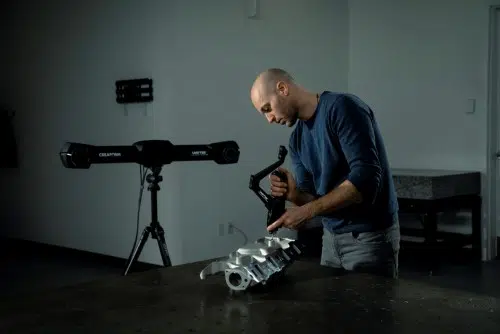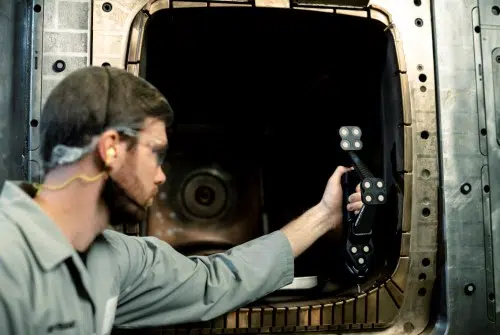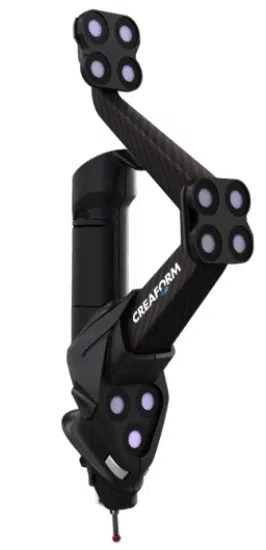The expectations for manufactured parts to be produced with precision are high, especially for complex automobile, aerospace, and medical device components. Small deviations in a part's dimensions can lead to costly failures for companies. This is why metrology is key in guaranteeing products meet exact specifications and adhere to quality standards. For advanced manufacturing and metal fabrication programs, teaching students about metrology and the importance of inspection and quality control will help students prepare for jobs in manufacturing. And with technology like 3D scanners, students can get hands-on experience understanding the inspection process.
The Role of Quality Control in Manufacturing
Quality control (QC) ensures that manufactured parts meet exact dimensional standards during inspection. In industries where precision is critical, such as aerospace, automotive, and medical devices, any deviation from exact specifications can lead to product failures, safety risks, or costly recalls. QC ensures that each part is measured and inspected to meet standards, maintaining product reliability and customer satisfaction. By implementing rigorous quality control processes, manufacturers reduce waste, prevent defects, and improve overall efficiency, all while delivering high-quality products that meet market demands.
Advancements in Technologies Used for Quality Control
As the demand for accurate and efficient inspection processes has increased, advanced technologies have been developed to cover quality control needs across a range of part types and sizes. Recent innovations have advanced QC by allowing the inspection of new features that could not be measured before with simple measuring tools like a tape or caliper, such as complex GD&T computations. Here's a look at some technologies used for inspection:
Optical 3D measuring systems
These systems are used to determine the geometric properties of objects from 2D photographic images. They are usually used with probing or 3D scanning measuring solutions because they are limited to measuring and tracking 3D Cartesian coordinates of optical references that are placed on a part.
3D Scanners
3D scanners are non-contact technologies for inspecting items. A 3D scanner is a device that analyzes a real-world object to capture its shape. The collected data is then used to construct a digital 3D model. 3D scanners are mostly used for design, reverse engineering, and prototyping, but they are also used for inspecting parts without having to make any physical contact. 3D scanners also allow effective measurement of a very high amount of data.

Coordinate Measuring Machines (CMM)
CMMs are the most widely used solution in the industry. They are a contact technology that includes a stylus or a probe, which makes actual contact with the part to measure it. The tips of most probes have spherical shapes with highly accurate diameters. However, probes are always manufactured with very stiff materials to reduce deflections during measurements that are not detected by the machine, which increases measurement uncertainty.
Photogrammetry
Photogrammetry, specifically stereophotogrammetry, determines the geometric properties of objects from 2D photographic images. It is used to obtain 3D coordinates of points on an object. This technology is useful for accurately measuring individual points on a part, but like optical 3D measuring systems, they usually complement probing or scanning technologies to complete inspections.
Why Use 3D Scanners to Teach Students Quality Control?
Taking an object from the physical world and bringing it into the digital world with a 3D scanner provides students with real-world skills while also engaging them with hands-on activities. 3D scanners use a laser beam or grids or lines of light to map out a collection of data points that represents the object's surface. The points are processed into a full 3D digital model that can then be used for inspection.
Incorporating 3D scanning into your curriculum exposes students to cutting-edge tools, giving them practical experience in using advanced technology to assess the quality of parts. 3D scanners also simplify the measurement of complex geometries that traditional tools may struggle to capture, enhancing students' problem-solving skills and understanding of the importance of precision and attention to detail in manufacturing.
3D Scanners for Teaching Quality Control
Creaform manufactures a range of 3D scanners used for quality control in industries including automotive, manufacturing, and aerospace. The Creaform HandyPROBE™ 3D scanner is a portable optical CMM that delivers unmatched accuracy regardless of the measurement setup, environmental instabilities, or user experience level.
The HandyPROBE can be easily moved around a classroom or shop, giving students endless options for inspecting items of varying sizes and shapes.
The 3D scanner also comes with a web-based software with didactic material to help you create presentations, share video tutorials, and make student exercises with sample datasets for hands-on experience with 3D files. For instructors in New England, AET Labs provides in-person training on the setup and operation of 3D scanners.
Real-World Examples Using 3D Scanners for Metrology
3D scanners help companies accomplish inspection and quality control tasks for a range of needs, with advantages in bringing flexibility, precision, and speed to the process.
Inspecting Manufactured Welding Jigs
AGT, a leader in developing and manufacturing automated industrial equipment, manufactures welding jigs for fabricated parts used in building the loading arm of a garbage truck, which lift steel garbage containers. The measuring system to inspect the jigs needs to continuously locate the parts since they are never completely immobilized. It is also a requirement to measure in a vibration-filled environment since the inspection has to take place at the AGT plant.
They use a Creafrom 3D scanner to conduct this challenging inspection process of measuring the welding jigs. The 3D scanner helps AGT save time and money, and they obtain better measurement information than a conventional measuring arm to deliver manufactured welding jigs that fulfill their client's expectations.
3D Scanners to Improve Quality Control in Additive Manufacturing
Many companies rely on additive manufacturing with 3D printers to create parts. However, because of the layer-by-layer printing process, they face quality issues in producing consistent components, especially for metal parts. 3D scanners help to quickly ensure 3D-printed items adhere to the original design intent and expected tolerances.
Lincoln Electric Additive Solutions specializes in producing large-format metal parts using additive manufacturing. The team uses steel, stainless steel, nickel-iron, nickel alloys and nickel-aluminum-bronze to develop metal part prototypes and replacements with clients ranging from the aerospace to heavy equipment and transportation sectors.
They use Creaform 3D scanners to quickly determine the dimensions and quality of large 3D-printed metal parts early on in the manufacturing process. This has reduced inspection times and costly production errors.
Quality control is critical to manufacturing, ensuring that products meet precise standards and customer expectations. With advancements in technology, tools like 3D scanners have revolutionized the way quality control is performed, offering speed, accuracy, and the ability to handle complex measurements. Integrating 3D scanners into the classroom offers an engaging way to teach students real-world inspection and quality control skills.
Find out how your New England advanced manufacturing or metal fabrication program can benefit from using a 3D scanner to teach the inspection process and much more! Contact AET Labs for more information and a quote.


